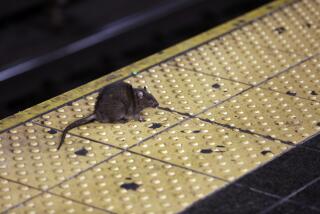Rats to Pull Weight for Science on Space Shuttle : Experiment: UCI researchers hope rodents will give clues on how weightlessness changes muscles.
- Share via
IRVINE — Researchers at UC Irvine believe five space-bound white rats can provide “the right stuff” in solving some human medical problems.
The rats will be placed aboard the space shuttle Columbia in an experiment to learn how weightlessness changes muscles.
Scientists have long known that muscle ability and size change in zero gravity, much the same way they do in plaster casts.
“It’s not surprising that it takes astronauts a few days to recover their preflight strength and coordination after a space mission,” said Kenneth Baldwin, a professor of physiology and biophysics at UCI.
Baldwin and Vincent Caiozzo, an assistant professor of orthopedics, say their study could have benefits ranging from enhancing prospects for long-term habitation in space to learning ways to reduce muscle loss when a broken limb is encased.
The laboratory rats will orbit Earth for about two weeks beginning Oct. 8.
Caiozzo and Baldwin say that previous research has led them to believe that muscle fibers respond to weightlessness by changing the way they function.
“Results from a similar experiment that flew for six days aboard space shuttle Endeavor last January suggest that (weightlessness) triggers muscle to be converted from slow-contracting fibers of the kind used in standing and walking to fast-contracting muscle that a sprinter uses,” Baldwin said.
Slow-contracting or “slow-twitch” muscles are the type used by long-distance cyclists and marathon runners, Baldwin said. “Fast-twitch” muscles are those used by high-speed runners. Such muscles provide power bursts, but they fatigue quickly.
Most people have an equal balance of slow-twitch and fast-twitch muscles, Baldwin said. But in space, that balance is thrown off.
Resistance-type exercises in space, such as lifting weights, may be one method for reducing muscle atrophy, the scientists said. There also may be a “pharmacologic solution,” such as a drug that might slow loss of muscle mass.
The UCI study of the rats’ muscle changes in space may provide more knowledge useful in finding both drug and exercise remedies, the two scientists said.
The research is funded by National Aeronautics and Space Administration grants that totaled about $100,000 annually for the past 10 years, the scientists said.






